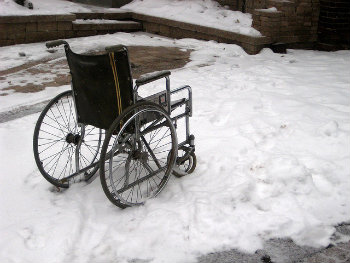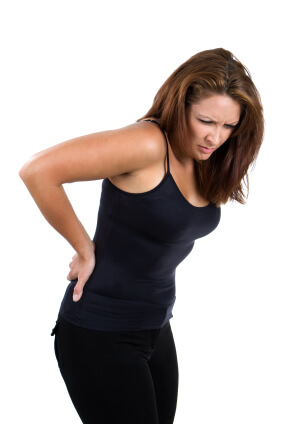It was the sickest I’ve ever been.
The first Monday in December of 2003 started off fairly ordinary, but quickly devolved into a medical nightmare. I remember getting up at 4:30, as is my custom, and sitting in meditation for half an hour, after my morning dose of tramadol. The theory is that while I meditate, the tramadol and the acetaminophen I take with it begin to reach higher levels of effectiveness and by the time I’m done meditating, I can engage in my daily yoga practice.
But that day, when the half hour meditation was up, I just felt awful. No improvement — even slightly worse than I usually do right before a regularly scheduled tramadol dose. Almost immediately, my young child awoke crying — unusual for her. I quickly determined that she was running a low fever, and had a few scattered red spots across her arms.
Thinking “chicken pox,” I called in sick to work and took her to the pediatrician. But by the time the doctor came into the room, it was pretty obvious that the sick person in the room wasn’t my daughter — it was me. I hurt all over, as people with fibromyalgia uusally do, but this was as intense as any bad flareup I’ve ever experienced, maybe more so. And I absolutely knew without doubt that I had a pretty high fever.
By the time we were discharged, I was keenly uncomfortable with putting my daughter in the back seat of a car that I was in charge of at that point. I called my husband, who had already left for work — he in turn called my brother who came to pick us up. I went home and crawled into bed as soon as my mother showed up to take care of my daughter.
By that evening, my fever had climbed to 104 degrees Fahrenheit, and I was hallucinating. Alternating doses every two hours of acetaminophen and Motrin were doing little to break that fever, and I was in so much pain and discomfort that sleep was impossible. Instead, I lay in some twilight fugue state between fully conscious and … something else entirely.
In the morning, my mother suggested she take me to the doctor’s office for tamiflu.
That’s when the insanity really started, by the way — quickly:
* my mother passed out in the waiting room due to a undiagnosed cardiac problem;
* since I couldn’t go with her to the emergency room due to my flu, my brother accompanied her;
* while waiting with her in the ER, my brother’s arm began to swell up;
* my husband came home to take care of us and the dog threw up on him.
Funny in retrospect, because we all survived — but at the time … wow. No fun. And my flu symptoms — the worst of them, I mean (the pain and the really high fever) — lasted for five days, despite taking tamiflu religiously.
In short, this was the absolute sickest I’ve ever been. And just how sick I’d been was driven home dramatically and tragically when I returned to work the following week to find out that a colleague’s secretary had died two days before — from the flu.and
As if the pain from fibro and degenerative disk disease weren’t enough!
It’s important for all of us to keep ourselves healthy — the flu is a serious illness. But that’s especially true for those of us who live with chronic pain conditions. And if the yearly flu season weren’t enough, now we have to consider H1N1 as well.
Here are some tips to keep yourself from catching the flu — any variety — this season.
Better Hygiene Practices Can Prevent a Lot of Illnesses
* Wash hands frequently.
* Antibacterial gel.
* Keep cleaning wipes handy for kitchen and bathroom
* Don’t forget to wipe down phones and doorknobs — also computer keyboards, your trackball or mouse, the alarm clock
* Get a separate toothpaste tube for each person in the house.
* Learn to love paper towels.
* Get creative with daily activities. Push elevator buttons with a pen. Turn off the lights with your elbow. Wear gloves when at the ATM or shopping with a credit card or debit card at the grocery store.
Diet Can Improve Your Immune Function
While there’s no magic food that can prevent the common cold or flu, research does tend to indicate that a healthful diet, combined with some specific foods known to have beneficial health effects can help you increase your immune system’s ability to fight off diseases.
* Yogurt: Shift workers who consumed a drink containing Lactobacillus reuteri, a probiotic that appears to stimulate infection-fighting white blood cells, were 33 percent less likely to take sick days than those who took a placebo, according to an 80-day Swedish study published in Environmental Health. But beware, says Elizabeth Somer, RD, author of 10 books on nutrition: “Some companies make up probiotic names to put on their label.” She suggests looking for yogurt that contains Lactobacillus acidophilus as well as Bifidus and L. rhamnosus. “They’re even more effective when combined,” she says.
* Garlic: According to a study published in Advances in Therapy, subjects who swallowed a garlic capsule for 12 winter weeks were two-thirds less likely to catch a cold; those who did suffered for 3 1/2 days less. Garlic contains allicin, a potent bacteria fighter, and other infection-fighting compounds, and Somer believes it’s even more effective in food form. She suggests adding one to three cooked cloves to your food each day.
* Black tea: Drinking 5 cups a day for 2 weeks can turn your immune system’s T cells into “Hulk cells” that produce 10 times more interferon, a protein that battles cold and flu infections, according to a Harvard study. Don’t like black tea? The green variety will also do the trick. If you can’t stomach drinking that much, you can still get added protection with fewer cups.
* Mushrooms: They contain more than 300 compounds that rev up immunity, in part by escalating the production of infection-fighting white blood cells and making them more aggressive. Shiitake, maitake, and reishi varieties contain the most immune-boosting chemicals, but plain old button mushrooms will also do the job.
* Fatty fish: Salmon, mackerel, herring, and other fatty fish contain omega-3 fatty acids, which increase activity of phagocytes — cells that fight flu by eating up bacteria — according to a study by Britain’s Institute of Human Nutrition and School of Medicine. They also contain selenium, which helps white blood cells produce cytokines, proteins that help clear viruses. Other research shows that omega-3s increase airflow and protect lungs from colds and respiratory infections. In fact, says Somer, DHA and EPA (the two main forms of omega-3s) benefit the immune system at the most basic level, enabling cell membranes to efficiently absorb nutrients and remove toxins.
Supplement Your Diet Wisely to Fight Off the Flu
Personally, it’s my belief that some folks put way too much faith in supplements. It’s universally considered more beneficial by researchers to get your vitamins and nutrients from food, instead of pills.
Even with Vitamin D, which isn’t easy to get a full dose of with a normal diet, your body can produce what you need with just a few minutes of sunlight daily (without sunscreen, so exercise caution, and if you have or might be susceptible to skin cancers, take a supplement and skip the sun). Each glass of milk contains about 100 IU of D, and the recommended daily allowance (RDA) in the US is 400 IU. Most reliable experts recommend about 1,000; you can take higher levels, but be warned that toxicity kicks in around the 50,000 IU level.
In addition to Vitamin D, you might want to think about upping your intake of the following nutrients and vitamins:
* Omega-3 fatty acids. Purified fish oil capsules with at least 1 g combined of EPA and DHA are best.
* Cold-fX. Yes, I’m usually skeptical, too, but read on: “Subjects who took two daily capsules of Cold-fX (available online), a supplement containing North American ginseng extract, caught half as many colds as a group taking a placebo, according to a study done by the Center for Immunotherapy of Cancer and Infectious Diseases at the University of Connecticut. When they did get sick, their symptoms lasted less than half as long. This particular ginseng variety contains compounds that increase white blood cells and interleukins, proteins the immune system relies on.” – from
* Zinc, when you have a cold or feel one coming on. Again, from ___: “The research on this mineral has been conflicting. Still, ’30 mg taken at the very start of a cold will shorten it by about half a day,’ says David L. Katz, MD, MPH, director of the Yale University Prevention Research Center. But don’t overdo it. While even a slight deficiency in zinc, which is needed to produce white blood cells, can increase your risk of infection, more than 50 mg daily can suppress your immune system and block absorption of other essential minerals.”
Mom Was Right: Get Your Sleep (and Exercise) to Boost Your Immunity
Nobody’s suggesting you take a daily hour-long aerobics class (though, God, I’d really like to be able to do that). But about half an hour of walking a day can have a therapeutic effect on your body’s ability to fight off and decrease stress, which impairs immune function.
Additionally, according to a study published in Medicine & Science in Sports & Exercise, regular physical activity — as long as it’s not extreme — lowers your overall risk of upper-respiratory infections.
Snooze for at least 7 hours a night. “A single night of sleep deprivation can depress your immune system,” says Katz. After 153 healthy men and women were exposed to a cold virus, those who had slept more than 7 hours each night during the preceding 14 days reduced their risk of contracting the rhinovirus by up to 300 percent, according to a 2009 study published in Archives of Internal Medicine. And get some solid shut-eye the night before your shot. According to research published in the Journal of the American Medical Association, when healthy men were limited to 4 hours of sleep before getting a vaccination, they developed only half the normal number of antibodies.
Try tai chi. When women ages 55 to 65 practiced tai chi for an hour 4 times a week, Shanghai University of Sport researchers saw the women’s levels of two different disease-fighting cells jump by nearly 32 percent over 4 months. Start practicing a week before your flu shot and you can boost its effectiveness by as much as 17 percent, found a University of Illinois study. To get started, try Element Tai Chi for Beginners ($15; collagevideo.com).
Party on — moderately. People who are socially active get fewer colds, even when intentionally exposed to the cold virus. Researchers postulate that frequent socializers tend to be more positive and maintain high-quality emotional ties, both of which strengthen immunity.
1. Cover your mouth and nose with a tissue when you sneeze. Okay. Everyone knows to do this…right? Then why do I still see so many people just letting their sneezes loose? Use a tissue or napkin and throw it away immediately afterwards. If a tissue isn’t available, sneeze into the inside of your elbow—not in your hands.
2. Wash your hands regularly. Another reminder you can never hear too many times. Use soap and water, or an alcohol based hand cleaner. Washing hands is especially important after sneezing or coughing, before handling food, or after spending time in a public place.
3. Don’t touch your face. Keep your hands away from your mouth, nose, and eyes. This is hard to do, but at least try to be aware if you’re doing it often. See above and wash frequently if you can’t keep your hands off yourself.
4. Get some sleep. Having a regular and appropriate sleep schedule is one of the best ways of keeping your immune system strong and staying healthy. The National Sleep Foundation recommends 7-9 hours per night for adults.
5. Be wary of surfaces—clean them regularly. Tables, chairs, countertops, desks, computer keyboards, doorknobs…pretty much everything you touch on a regular basis. Most common household disinfectants should work fine to keep them germ-free.
6. Exercise. A sure way to make sure your body is strong and ready to fight infection is to stay active. Make exercise a part of your daily routine to cleanse toxins from your body and release stress.
7. Eat well. Maintain a diet full of immune boosting foods and high in Antioxidants, such as vegetables, fruits, and whole grains.
8. Drink well. Have plenty of water to flush toxins from your system. Vitamin-C rich fruit juice is a good choice as well. Avoid alcohol—it’s an immune suppressant.
9. Stay away from sick people. A few feet should do it. Just stay far enough away from sick friends to be out of range of saliva, snot, and other potential disease carrying fluids.
10. Get help when you need it. If you start experiencing flu-like symptoms such as fever, coughing, sneezing, chills, body aches, etc., call your doctor. Do your co-workers or classmates, and yourself, a favor by staying home for at least 24 hours—except to see a doctor.
11. Stay calm. There’s likely to be plenty of swine flu coverage in the media over the next few months, but nothing does your body more of a disservice than unnecessary stress and panic. If we’re smart, cautious, and relaxed, we have little reason to fear.
It was the sickest I’ve ever been.
The first Monday in December of 2003 started off fairly ordinary, but quickly devolved into a medical nightmare. I remember getting up at 4:30, as is my custom, and sitting in meditation for half an hour, after my morning dose of tramadol. The theory is that while I meditate, the tramadol and the acetaminophen I take with it begin to reach higher levels of effectiveness and by the time I’m done meditating, I can engage in my daily yoga practice.
But that day, when the half hour meditation was up, I just felt awful. No improvement — even slightly worse than I usually do right before a regularly scheduled tramadol dose. Almost immediately, my young child awoke crying — unusual for her. I quickly determined that she was running a low fever, and had a few scattered red spots across her arms.
Thinking she might have chicken pox, I called in sick to work and took her to the pediatrician. But by the time the doctor came into the room, it was pretty obvious that the sick person in the room wasn’t my daughter — it was me. I hurt all over, as people with fibromyalgia uusally do, but this was as intense as any bad flareup I’ve ever experienced, maybe more so. And I absolutely knew without doubt that I had a pretty high fever.
By the time we were discharged (without the chicken pox, thank goodness), I was keenly uncomfortable with putting my daughter in the back seat of a car that I was in charge of at that point. I called my husband, who had already left for work — he in turn called my brother who came to pick us up. I went home and crawled into bed as soon as my mother showed up to take care of my daughter.
By that evening, my fever had climbed to 104 degrees Fahrenheit, and I was hallucinating. Alternating doses every two hours of acetaminophen and Motrin were doing little to break that fever, and I was in so much pain and discomfort that sleep was impossible. Instead, I lay in some twilight fugue state between fully conscious and … something else entirely.
In the morning, my mother suggested she take me to the doctor’s office for tamiflu. That’s when the insanity really started, by the way — quickly:
- my mother passed out in the waiting room due to a undiagnosed cardiac problem;
- since I couldn’t go with her to the emergency room due to my flu, my brother accompanied her;
- while waiting with her in the ER, my brother’s arm began to swell up;
- my husband came home to take care of us and the dog threw up on him.
Funny in retrospect, because we all survived — but at the time … wow. No fun. And my flu symptoms — the worst of them, I mean (the pain and the really high fever) — lasted for five days, despite taking tamiflu religiously.
In short, this was the absolute sickest I’ve ever been. And just how sick I’d been was driven home dramatically and tragically when I returned to work the following week to find out that a colleague’s secretary had died two days before — from the flu.
As if the pain from fibro and degenerative disk disease weren’t enough!
It’s important for all of us to keep ourselves healthy — the flu is a serious illness. But that’s especially true for those of us who live with chronic pain conditions. And if the yearly flu season weren’t enough, now we have to consider H1N1 as well.
Here are some tips to keep yourself from catching the flu — any variety — this season.
Better Hygiene Practices Can Prevent a Lot of Illnesses
- Wash hands frequently and thoroughly.
- Antibacterial gel — keep it handy at all times.
- Keep cleaning wipes handy for kitchen and bathroom. Wipe down all surfaces you regularly touch.
- Don’t forget to wipe down phones and doorknobs — also computer keyboards, your trackball or mouse, the alarm clock — anything you or your family touch frequently.
- Get a separate toothpaste tube for each person in the house to cut down on germs transferred by touching toothbrush to the tip of the tube.
- Learn to love paper towels. Use them instead of washable towels and sponges.
- Get creative with daily activities. Push elevator buttons with a pen. Turn off the lights with your elbow. Wear gloves when at the ATM or shopping with a credit card or debit card at the grocery store.
- Keep your hands away from your face.
Diet Can Improve Your Immune Function
While there’s no magic food that can prevent the common cold or flu, research does tend to indicate that a healthful diet, combined with some specific foods known to have beneficial health effects can help you increase your immune system’s ability to fight off diseases.
- Yogurt: A recent Swedish study published in Environmental Health showed that probiotic-drink-swilling workers took a third fewer sick days than their colleagues who downed a placebo version. Look for labels that specify Lactobacillus acidophilus, Bifidus and L. rhamnosus.
- Garlic: A key ingredient in garlic — allicin — is a strong antibacterial. Aim for a few cloves added to your food daily.
- Black tea and green tea: If you can handle it, imbibe up to 5 cups each day instead of coffee. A Harvard study showed that doing so increases interferon levels up to 10 times the normal level. Interferon, of course, is a protein that helps protect your body against certain infections, including colds and the flu.
- Mushrooms: These little suckers are powerhouses of immunity-increasing action. Some resources suggest that the shiitake, maitake, and reishi varieties do the most good. The regular white capped button variety will work, too.
- Salmon, mackerel, and other fatty fish contain omega-3 fatty acids, which can help increase your body’s ability to fight off bacteria and protect against respiratory infections.
Supplement Your Diet Wisely to Fight Off the Flu
Personally, it’s my belief that some folks put way too much faith in supplements. It’s universally considered more beneficial by researchers to get your vitamins and nutrients from food, instead of pills.
Even with Vitamin D, which isn’t easy to get a full dose of with a normal diet, your body can produce what you need with just a few minutes of sunlight daily (without sunscreen, so exercise caution, and if you have or might be susceptible to skin cancers, take a supplement and skip the sun). Each glass of milk contains about 100 IU of D, and the recommended daily allowance (RDA) in the US is 400 IU. Most reliable experts recommend about 1,000; you can take higher levels, but be warned that toxicity kicks in around the 50,000 IU level.
In addition to Vitamin D, you might want to think about upping your intake of the following nutrients and vitamins:
-
Omega-3 fatty acids
. Purified fish oil capsules with at least 1 g combined of EPA and DHA are best. If you just can’t stand those fatty fish, look for these.
-
Cold-fX
. Yes, I’m usually skeptical, too, but this one apparently works.
-
Zinc
, when you have a cold or feel one coming on. Also has some skepticism and mixed results behind it, but worth a try.
Mom Was Right: Get Your Sleep (and Exercise) to Boost Your Immunity
Nobody’s suggesting you take a daily hour-long aerobics class (though, God, I’d really like to be able to do that). But about half an hour of walking a day can have a therapeutic effect on your body’s ability to fight off and decrease stress, which impairs immune function.
Additionally, according to a study published in Medicine & Science in Sports & Exercise, getting moderate, daily exercise can reduce your chances of developing upper-respiratory infections. Just don’t overdo it; extreme exercise apparently weakens your immune response.
Along with that, you might want to consider trying tai chi. According to researchers at Shanghai University of Sport, women between 55 and 65 who engaged in an hour-long tai chi practice session four times a week, their levels of illness-destroying cells increased over 30 percent over a four-month period. Those results were supported by another study at the University of Illinois, which found that people who took up tai chi a week before getting a flu vaccination improved the shot’s efficacy by over 15 percent.
Whatever amount of sleep is right for you (and it varies for all of us), get it every night. Be hard-headed and insist on it. Take this seriously, because healthy, deep, sufficient sleep is critical for chronic pain patients in any event. It will also improve your immune system’s efficacy. A 2009 study published in Archives of Internal Medicine showed up to 300% reduction in risk of contracting rhinovirus for those who slept more than 7 hours regularly.
If You Do Get Sick, Here’s What to Do
If you do get sick, follow Mom’s orders: stay home. Call your doctor, but do not go to work or school. This is how disease spreads! Do your coworkers and yourself a favor — stay home and rest. Drink liquids — water, Gatorade, juices as able (cut them with water if you have a hard time swallowing the full-strength stuff when you’re sick).
And despite the “swine flu” hysteria in the press, don’t freak out. Staying calm can help your body regulate its normal stress levels and improve your ability to stay well over the flu season months. Don’t buy into the hype. Just be smart, and arm yourself with knowledge from trustworthy sources. (Anyone who starts a post or tweet or comment with “my aunt says” or “according to experts” but won’t name those experts? Proceed with caution, people!)
Stay well, and remember to thrive — not just survive!
 Note from Annie: Today’s post is a guest post from Molly Clarke, and I think it’ll offer some answers to questions a lot of Dolls have about Social Security Disability – enjoy!
Note from Annie: Today’s post is a guest post from Molly Clarke, and I think it’ll offer some answers to questions a lot of Dolls have about Social Security Disability – enjoy!





